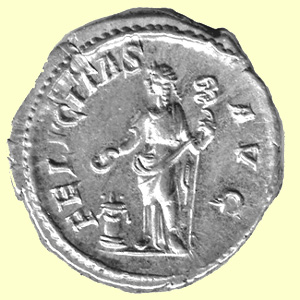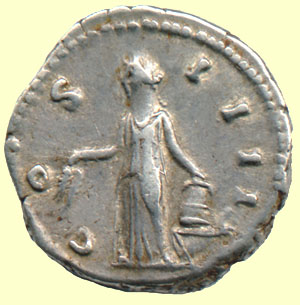 Contents -
Previous Article -
Next Article
Contents -
Previous Article -
Next Article
Using Compact Symbols to Broadcast News and Ideas
The reverse of the coin was the tiny space where the emperor could display his message. The ancient peoples communicated with symbols in much the same way as we do today. Almost everyone understands what a large red octagon means even if they cannot read the word "STOP" printed within it. A picture of a telephone hand piece announces the presence of a pay phone, and a silhouette of a person in skirts helps us to tell the ladies’ rest room from the men’s room, which is identified by a silhouetted figure wearing trousers. Crosses identify Christian churches while a Menorah or a Star of David symbolize the Jewish faith and nation. Finally, we use a very healthy looking female figure striking a suitably heroic pose to symbolize the idea of "liberty". This figure, by extension, also symbolizes the United States of America.
In the coin image above, the female figure is Felicitas, or the personification of happiness. She holds two attributes, a caduceus, or wand of Mercury, and a patera, or sacrificial bowl. She is sprinkling a grain sacrifice out of the patera over a small altar. The image of Felicitas symbolized in general that things were going well for the Roman Empire, emperor, and the people. Felicitas was often used to convey the very specific message that the empress had borne a child.
In these examples, I began by describing very concrete symbols that gave warnings or directions. These are everywhere in our society, being especially prevalent in recent years with the arrival of so many non English speaking immigrants. These kinds of symbols were used to some extent in Roman times as well. I also described symbols that stood for more abstract ideas like Christianity, Judaism, and liberty. This last example of liberty is used in our society in exactly the same way it was used on Roman coin reverses. The difference was is that they had dozens of different female figures and a few male figures symbolizing all kinds of ideas. They had their figure of liberty (LIBERTAS). She is shown holding a liberty cap (PILEUS) and a sceptre, both of which are also symbolic images.
It is interesting to note that this idea of communication using pictorial symbols is not a device unique to the ancient world. As the world became more "educated", we learned to rely more and more on just the written word for the imparting of knowledge from one person to another. In our high tech world, we have seen a definite return to this very effective means of communication that served the ancients so well. Our Web pages and computer screen are covered with pictographic icons. As this trend has developed over the past decade and a half, this kind of symbolic representation has in fact evolved into a language with a grammar all its own, with rules and conventions. What comes to mind when you see an icon on your screen of a little house, a question mark, left and right arrows, a stop sign, or text underlined and highlighted in blue?
 Roman coin reverses were a medium of communication that did a job far out of proportion to their size. Hundreds of standard reverse messages have been catalogued and many of them could be understood even by illiterate peasants. The female figure Annona holding a cornucopia, or horn of plenty and ears of grain with the legend ANNONA AVG on the reverse of a coin indicates that the emperor wishes to be known for his diligence in ensuring an adequate grain supply for the people. In this example, Annona is shown holding two ears of grain and a modius, both symbols of a plentiful grain harvest.
Roman coin reverses were a medium of communication that did a job far out of proportion to their size. Hundreds of standard reverse messages have been catalogued and many of them could be understood even by illiterate peasants. The female figure Annona holding a cornucopia, or horn of plenty and ears of grain with the legend ANNONA AVG on the reverse of a coin indicates that the emperor wishes to be known for his diligence in ensuring an adequate grain supply for the people. In this example, Annona is shown holding two ears of grain and a modius, both symbols of a plentiful grain harvest.
One of the things that scholars find a little humorous is the examples of wishful thinking expressed by emperors who only lasted a few weeks or months before being murdered by the Praetorian Guard. They often struck coin reverses announcing "Loyalty of the army" (FIDES MILITVM) and showing the female figure of loyalty standing smartly at attention holding a military standard! These emperors might last only as long as they could keep the troops well supplied with money from their own personal fortunes. When the cash ran out the troops, ignoring the complimentary reference to their loyalty, went ahead and cut the poor fool’s throat and put another rich sucker of their choosing on the throne.
The next article in this series deals in detail with the different kinds of symbolic images found on Roman coin reverses. These include sumbolic objects, allegorical figures or personnifications, and gods or goddesses. Specific reverse types which are associated with individual emperors or distinct periods in time will be found on other pages. Each of these has an introduction and links to pages specifically devoted to the symbolic device or reverse type being discussed. The author hopes that as this series of articles develops, the Roman coin fancier will have access to an ever increasing data bank of information and visual resources to use in identifying, attributing, and enjoying his or her own Roman coin collection.
Go to next article: A Gallery of Reverse Images and What They Symbolize
Go back to previous article: Many Languages and Cultures Within One Great Empire
Return to Roman Coins Table of Contents
 Roman coin reverses were a medium of communication that did a job far out of proportion to their size. Hundreds of standard reverse messages have been catalogued and many of them could be understood even by illiterate peasants. The female figure Annona holding a cornucopia, or horn of plenty and ears of grain with the legend ANNONA AVG on the reverse of a coin indicates that the emperor wishes to be known for his diligence in ensuring an adequate grain supply for the people. In this example, Annona is shown holding two ears of grain and a modius, both symbols of a plentiful grain harvest.
Roman coin reverses were a medium of communication that did a job far out of proportion to their size. Hundreds of standard reverse messages have been catalogued and many of them could be understood even by illiterate peasants. The female figure Annona holding a cornucopia, or horn of plenty and ears of grain with the legend ANNONA AVG on the reverse of a coin indicates that the emperor wishes to be known for his diligence in ensuring an adequate grain supply for the people. In this example, Annona is shown holding two ears of grain and a modius, both symbols of a plentiful grain harvest.
 Contents -
Previous Article -
Next Article
Contents -
Previous Article -
Next Article